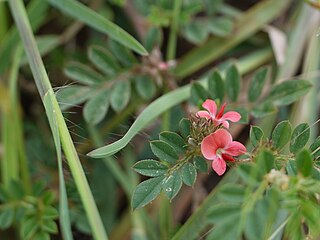
Tristerix is a genus of mistletoe in the family Loranthaceae, native to the Andes, ranging from Colombia and Ecuador to Chile and Argentina. They are woody perennials usually occurring as aerial parasites, are pollinated by hummingbirds and flowerpiercers, with seed-dispersal generally by birds but occasionally by mammals (Dromiciops). The genus is distinguished from other New World Loranthaceae by its simple, terminal, racemose inflorescences, together with its of 4- or 5-merous flowers, versatile anthers, and the presence of endosperm. Further differences include fused cotyledons and the absence of epicortical roots.

Neolitsea dealbata, also known as white bolly gum, hairy-leaved bolly gum, or simply bolly gum, is a shrub or small tree in the laurel family Lauraceae which is native to New South Wales and Queensland in Australia.

Lysiana is a genus of hemiparasitic shrubs endemic to Australia, in the family Loranthaceae.

Atkinsonia is a hemi-parasitic shrub with oppositely set, entire leaves and yellowish, later rusty-red colored flowers, that is found in Eastern Australia. It is a monotypic genus, the only species being Atkinsonia ligustrina, and is assigned to the showy mistletoe family, Loranthaceae. It is sometimes called Louisa's mistletoe.

Tristerix aphyllus is a holoparasitic plant species of the genus Tristerix in the family Loranthaceae. It is endemic to Chile. T. aphyllus is sometimes called the "cactus mistletoe." It should not be confused with the mistletoe cactus, which is an epiphytic cactus, and not a mistletoe.

Amyema bifurcata is an epiphytic, flowering, hemiparasitic plant of the family Loranthaceae native to Australia and found in Western Australia, the Northern Territory, Queensland and New South Wales.

Amyema maidenii is a species of flowering plant within the genus Amyema, an epiphytic hemiparasitic plant of the family Loranthaceae native to Australia and found Australia-wide in the inland.

Amyema mackayensis, the mangrove mistletoe, is a species of flowering plant within the genus Amyema, an epiphytic hemiparasitic plant of the family Loranthaceae native to Australia, and found along its northern and eastern coasts in New South Wales, Queensland, the Northern Territory and Western Australia, and also in New Guinea.

Amyema biniflora, the twin-flower mistletoe, is a species of flowering plant within the genus Amyema, an epiphytic hemiparasitic plant of the family Loranthaceae endemic to Queensland, Australia.

Amyema sanguinea is an aerial hemiparasitic shrub within the genus Amyema, in the family Loranthaceae and native to Australia, where it is found in New South Wales, Queensland, the Northern Territory, South Australia and Western Australia.

Amyema melaleucae, also known as the tea-tree mistletoe, is a species of flowering plant within the genus Amyema, an epiphytic hemiparasitic plant of the family Loranthaceae native to Australia and found in Western Australia and South Australia on the coast, from north of Perth almost to the Victorian border.

Muellerina bidwillii, common name Cypress-pine mistletoe, is a hemiparasitic aerial shrub in the family Loranthaceae. The species is endemic to New South Wales and Queensland.

Lysiana murrayi is an erect or spreading hemi-parasitic shrub in the Loranthaceae which occurs in all mainland states of Australia except Victoria. It has flat narrow leaves. The leaves are 2.5–6 cm long, 1–3.5 mm wide, do not have a distinct petiole, and the venation is not visible. The inflorescence is a solitary flower or pair of flowers without a common peduncle. The pedicels are 8–20 mm long, and strongly winged towards the apex. The spreading, membranous bracts are 2–3 mm long, and rounded at the apex. The corolla of the mature bud is usually 18–28 mm long, and white, yellow or pink. The fruit is globose, 7–12 mm long, and pink or red.

Muellerina myrtifolia, common name myrtle-leaved mistletoe, is a hemiparasitic aerial shrub in the family Loranthaceae. The species is endemic to New South Wales and Queensland.

Muellerina celastroides, common names Banksia mistletoe and coast mistletoe, is a hemiparasitic aerial shrub in the family Loranthaceae. The species is endemic to New South Wales, Victoria and Queensland.
Psittacanthus biternatus is a species of mistletoe in the family Loranthaceae, which is native to Brazil, Venezuela, and Colombia.

Indigofera linnaei, known as Birdsville indigo and nine-leaved indigo, is a species of leguminous shrub in the genus Indigofera. The genus name, Indigofera, is derived from Latin and means bearing/containing indigo, while linnaei derives from Linnaeus.

Lysiana subfalcata, common name Northern mistletoe, is a spreading to pendulous hemi-parasitic shrub in the Loranthaceae which occurs in all mainland states of Australia except Victoria.

Amylotheca is a genus of hemi-parasitic aerial shrubs in the family Loranthaceae, found in Borneo, Malaysia, New Caledonia, New Guinea, Australia, Sumatra, Thailand, Vanuatu, and Philippines
Amyema plicatula is a species of hemi-parasitic shrub found in the Bismarck Archipelago, New Guinea, New South Wales and Queensland.



















